Stalingrad "boiler"
22 November
On November 22, the columns of the headquarters of the 6th German army arrived in Nizhne-Chirskaya, where Paulus and the chief of staff of the army Schmidt were. There was also Colonel General Goth, commander of the 4th tank the army. At this time, a radiogram was received from Hitler. Goth and his headquarters responded to other tasks. Paulus and Schmidt were ordered to immediately fly out of the formed “cauldron” and to place an army command post near the Gumrak station. It also became known that the 14th Panzer Corps of General Hube, which was supposed to suspend the advance of the Russian troops by attacking them from the flank, was pushed east of the Don, as was the 11th Army Corps. The strategically important bridge across the Don at Kalach was given without a fight. The south path — the retreat of the 6th Army — was largely cut. The advance detachments of the Russians went out to Kalach.
Soviet troops continued to develop the offensive. To connect with the troops of the Stalingrad Front, moving from the southeast, mobile units of the South-Western Front were to force the r. Don. The only bridge crossing over the Don in the offensive zone of the 26 and 4 tanks was at the village of Berezovsky in the area of Kalach. The Germans also understood perfectly the meaning of this item. To cover the approaches to the bridge in the Kalach area, the Germans occupied a bridgehead on the western, high bank of the Don, facing the front to the rear, since it was believed that Soviet troops would try to occupy Kalach. The bridge was prepared for destruction. However, the enemy failed to hold the bridge in his hands, nor to blow it up.
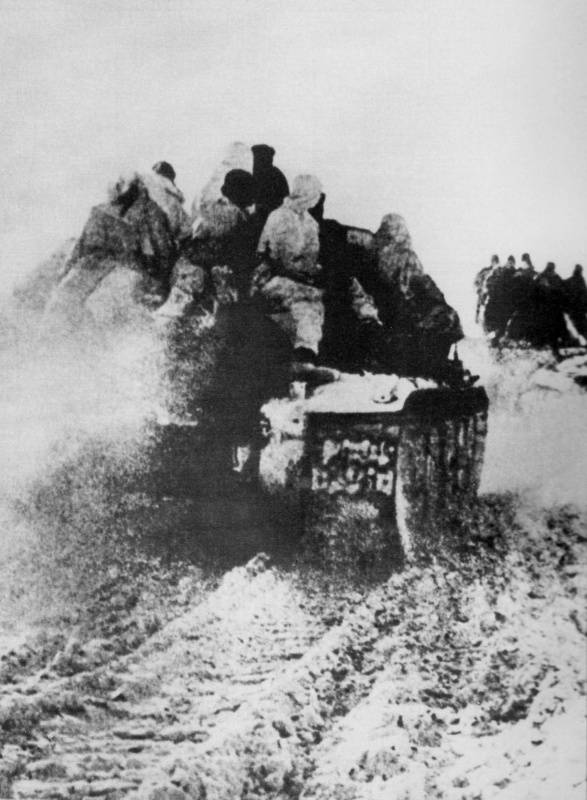
Soviet T-34 tanks with soldiers on armor on the march in the snow-covered steppe during the Stalingrad operation. Photo source: http://waralbum.ru/
On the night from 21 to 22 in November, the 26 tank Corps occupied the settlements of Dobrinka and Ostrov. Corps commander Rodin decided to take advantage of the darkness for the sudden capture of a bridge crossing over the Don. This task was assigned to the forward detachment under the command of the commander of the 14 motorized rifle brigade, Lieutenant Colonel G. N. Filippov. The advanced detachment included: two motorized rifle companies of the 14 th motorized rifle brigade, five tanks of the 157 th tank brigade and an armored vehicle of the 15 th separate reconnaissance battalion. In the 3 o'clock in the morning on November 22, the forward detachment began to move at high speed along the Ostrov-Kalach road. Lt. Col. Filippov led a detachment of cars and tanks with headlights on to deceive the enemy. Indeed, the Germans took the column for their own (the German training unit, equipped with captured Russian tanks) and the enemy defense was passed without a single shot. In the rear of the enemy, a detachment met a local resident's wagon, who showed the way to the crossing and spoke about the German defense system. In 6 hours, calmly approaching the crossing, a part of the detachment passed by car across the bridge to the left bank of the Don and gave the rocket a sign to the others. In a short, sudden battle for the enemy, the guard of the bridge was interrupted. The detachment occupied the bridge, and then even made an attempt to seize the town of Kalach on the move. The enemy had organized resistance and tried to repel the crossing. Filippov's squad took all-round defense and steadfastly fought off all attacks of the superior forces of the enemy, holding the bridge until the approach of his corps.
On this day, the main forces of the 26 Corps were engaged in serious battles at the turn of the state farm "Victory of October" (15 km west of Kalach) and "10 of October years". Here the enemy, relying on a previously prepared anti-tank area, stubbornly resisted the advancement of body parts to the crossing. The Germans used previously damaged tanks, which were turned into fixed firing points. Only by the 14 clock, having made a roundabout maneuver, did the 157-I tank brigade take the heights 162,9 and 159,2. The enemy suffered heavy losses and retreated. 19-I tank brigade of Colonel N. M. Filippenko, overcoming the resistance of the enemy, to the 17 hour. part of the forces went to the crossing of the river. Don, which kept the vanguard of the corps. K 20 hour. the whole team crossed the Don River and concentrated in the northeastern Kalacha forest. The 1 tank corps also advanced successfully. The tank brigades of the 4 tank corps crossed the Don across the captured bridge from the Berezovsky farm and entrenched on the east bank. In the meantime, cavalry and infantry units of the South-Western Front consolidated the successes achieved. Part of the forces of the front led the fighting to destroy the enemy's forces, which were in the rear of the rapidly advancing Soviet mobile units.
23 November. Stalingrad "boiler"
On this day, the enemy grouping was completely blocked in the area of Bazkovsky, Raspopinskaya, Belosoin. The divisions of the 21 and 5 of the Romanian corps (4, 5, 5, 6 and 13-I infantry divisions) were in the rifle ring of the 14 and 15 tank armies. Romanians still fought back, hoping for help from the outside. However, these hopes were not justified. Back in the night from 22 to 23 in November to the south of Golovskiy, some of the forces from the surrounded group capitulated. Among the captured Romanians captured by the Soviet troops were the commander of the 5 infantry division, General Mazarini, the commander of the 6 infantry division, General Lascar, the chief of staff of the 6 infantry division, Lieutenant Colonel Cambre and other commanders. The remaining Romanian troops fought back at Raspopinskaya. By the end of the day, Brigadier General Traian Stanescu, who commanded the surrounded Romanian troops, sent envoys to negotiate for surrender.
The Romanians outlined the conditions for surrender: all soldiers and officers who surrendered were guaranteed life, good treatment and the safety of personal belongings at each. All weapons, as well as horse, train and other military property were subject to surrender to Soviet troops. On the night of 23 on November 24, and then the whole day of November 24, the Romanians laid down weapon and surrendered. Then the columns of prisoners moved to the rear. In total, around 27, thousands of enemy soldiers and officers were taken prisoner in the Raspopinskaya district, and a significant amount of weapons and other military trophies were captured. The infantry units of the 21 and 5 tank armies, which had been liberated after the liquidation of the Raspopinsky group, continued to move in a southeastern direction, reinforcing the front of troops on the west bank of the Don.
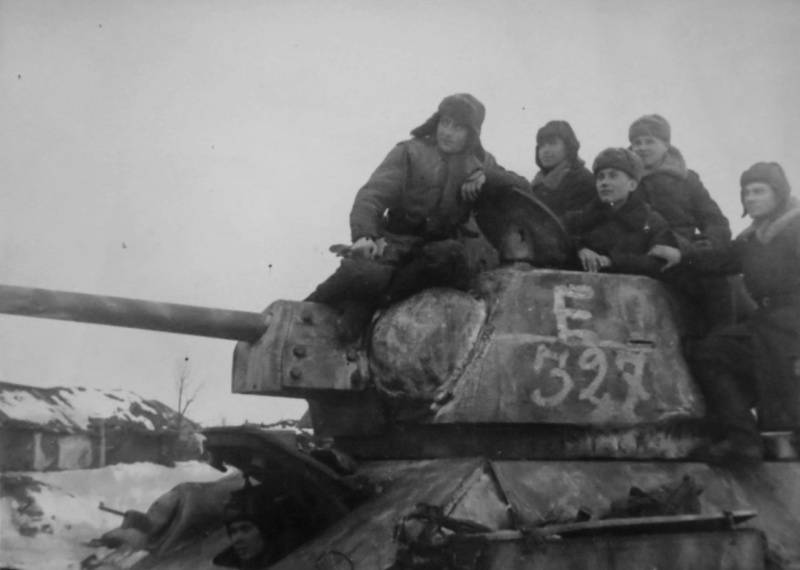
Tankers 24 of the Soviet tank corps on the armor T-34
On the same day, Soviet troops liberated Kalach. At 7 in the morning the 19-I tank tank brigade of the 26 tank corps launched an attack on the enemy’s garrison in Kalach. By 10 hours Soviet tanks broke into the city, but the Germans stubbornly resisted. They stopped the advance of our troops in the north-western outskirts of the city. Then, the attackers came to the aid of the attacking units of the 157 Tank Brigade, which by this time had advanced to the right bank of the Don. Motorized rifle units of the brigade began to cross the Don across the ice and then attacked the enemy from the southwestern outskirts of Kalach. At the same time, tanks pulled up to the high right bank of the Don opened fire on enemy firing points and a cluster of his vehicles. The enemy did not expect a strike from this side and flinch. Our troops attacked again in the north-western outskirts of the city. By 14 watch, Kalach was released.
The remaining mobile units of the front also successfully attacked, breaking the resistance of the enemy and freeing settlements. “All attempts by the enemy to prevent the encirclement were overdue,” noted K. K. Rokossovsky. - The Nazi units, tank and motorized, being transferred from the area of Stalingrad to the place of the resulting breakthrough, were introduced into the battle piecemeal and, falling under the blows of our superior forces, were defeated. They produced the same picture as with the units of the Red Army in the battles in the great bend of the Don. By not taking a cardinal decision to retreat in time, the fascist German command, like ours at one time, tried to impose small “patches” on the ever-widening huge gap in the Stalingrad direction. ”
The 65 Army of the Don Front during 20 - 23 in November, together with the 3 Guards Corps of the 21 Army of the Southwestern Front, took control of the settlements Tsimlovskiy, Platonov, Orekhov, Logovskiy, Upper Buzinovka, and the Vegekovsky, Ugov, Orekhov, Logovsky, Upper Buzinovka, and the Vegekovsky, Nogov, Orekhov, Logovsky, Upper Buzinovka. Broken German troops, including the 14 Tank Division, retreated to Stalingrad. 24-I army, leading the offensive along the left bank of the Don, came across a strong defense of the enemy, so did not have much success.
The troops of the shock group of the Stalingrad Front solved their main task. Having broken through the front on the left flank of the 4 of the Romanian army, the rifle formations of the 57 and 51 of the armies moved in the wake of their mobile formations — the 13 tank and the 4 mechanized and 4 cavalry corps. The Germans, trying to keep the 57 army offensive, threw units of the 29 motorized division into battle. They had little success, but in battles 21 - November 22 were defeated. By the end of November 22, connections of the 64 and 57 armies covered the Stalingrad enemy grouping from the south and south-west. All the routes of the Germans to the south and south-west were closed.
In the offensive zone of the 51 Army, on the left wing of the front attack force, the 4 Mechanic Corps of General Volsky moved ahead of the other attacking forces. November 20 was still occupied by prolific parts, November November 21 - art. Abganerovo and Art. Tinguta. As a result, our troops cut the Stalingrad-Salsk railway line and interrupted telegraph and telephone communication. The work of the main highway was violated, on which the Stalingrad Wehrmacht group received reinforcements, equipment and ammunition. The 4 th cavalcourse, which entered the breakthrough after Volsky's connection, made an 65-kilometer-long march-maneuver with the task of cutting off the enemy's escape routes to Abganerovo. The 13 tank corps of Colonel Tanaschishin continued to move to the north-west, interacting with the compound of General Volsky.
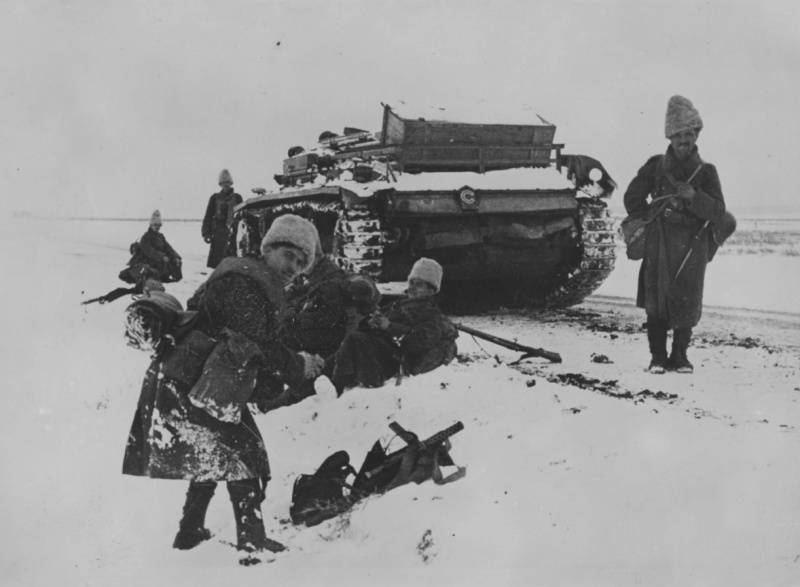
Infantry 4 of the Romanian army on vacation at ACS StuG III Ausf. F on the road near Stalingrad
In the afternoon of November 22, units of the Volsky mekhkorpus, breaking through to meet the troops of General Romanenko's 5 tank army, captured the Soviet farm. At this time, the formations of the 51 Army and the 4 Corps, advancing on the outer flank of the encirclement of the enemy group, were moving in the direction of Kotelnikovo. The troops of the South-Western and Stalingrad fronts separated the distance of just 10 - 15 km after the 26-th and 4-th tank corps reached the Kalach area, and the 4-th mechanized corps - to the Soviet area. The German command, trying to keep the path of retreat, threw out of Stalingrad to Kalach and the Soviet 24 and 16 tank divisions. However, our troops repelled all enemy counterattacks. November 23 16-X and 45-I tank brigades of the 69-x tank corps and 4-I mechanized brigade of the 36-mechanized corps united in the Soviet farm in the 4 watch.
Thus, on the fifth day after the start of the counteroffensive in the Kalach area, the Soviet farm of the Southwestern and Stalingrad fronts closed the operational circle around the Stalingrad enemy grouping.
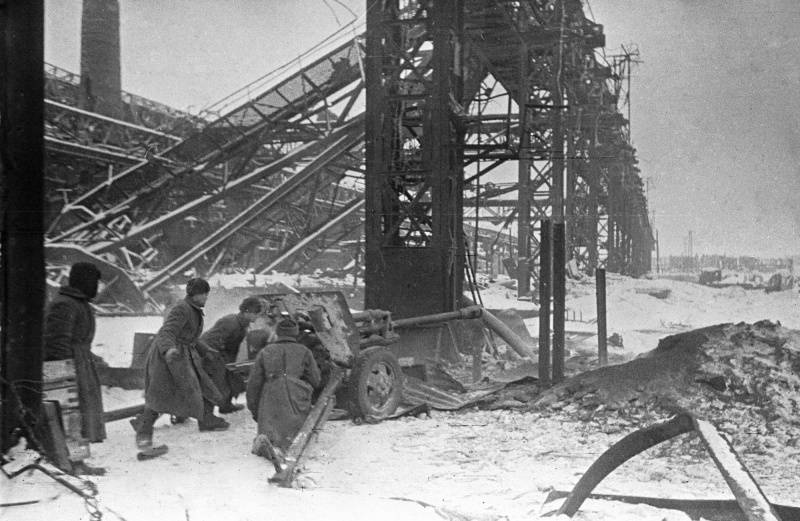
Calculation of the Soviet gun ZiS-3 at the factory "Red October" in Stalingrad
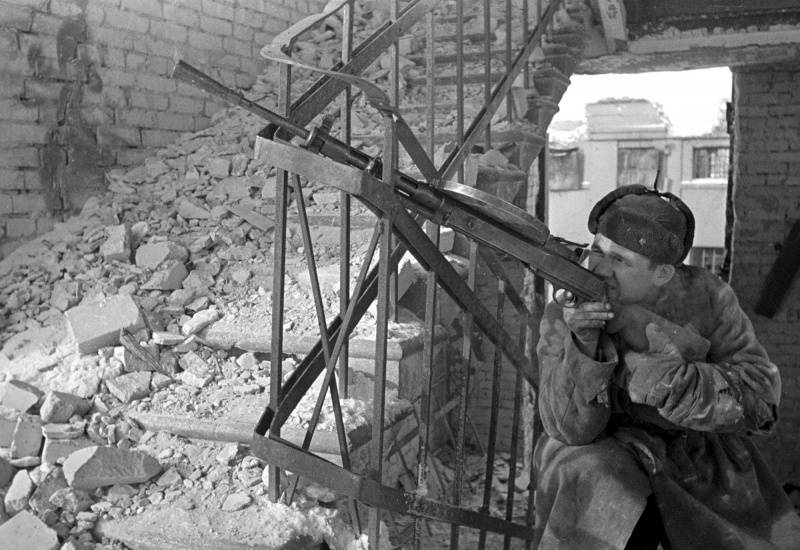
Soviet machine gunner with DP-27 in one of the destroyed houses of Stalingrad
Attempt to go to destroy the German group
A large grouping of the enemy — the 6 and part of the 4 th tank armies of the German armies — was included in the 22 divisions, totaling about 330 thousand people. In addition, during the offensive, the Soviet troops defeated the 3 Rumanian army, five divisions of which were destroyed or taken prisoner, and inflicted a serious defeat on the units of the 4 Rumanian army. The enemy’s 48 tank corps, which made up its operational reserve, was also defeated.
At the same time there was no solid front. The total length of the external front was over 450 km. However, the troops actually covered only about 270 km. The minimum distance of the external front from the internal one was only 15 - 20 km (Soviet - Lower-Chirskaya and Soviet - Aksai). It was on the most dangerous areas, where the enemy could put a deblocking counterstrike. The Germans did not have a solid line of defense either. At the front of the enemy, a huge gap wider than 300 km (from Bokovskaya to Lake Sarpa) was punched.
23 November, Paulus, not yet knowing that the ring of the environment had closed, in the radiogram of Hitler raised the question of withdrawing from the Volga positions. “The army will soon be on the brink of destruction, if it is not possible, having concentrated all forces, to defeat the enemy troops advancing from the south and west,” the German commander reported. - For this, it is necessary to immediately remove all divisions from Stalingrad and significant forces from the northern sector of the front. The inevitable consequence of this should be a breakthrough in the south-west direction, since it is impossible to organize the defense of the eastern and northern parts of the front with such insignificant forces ... Considering the current situation, I ask you once again to give me freedom of action ... ”.
November 24 Hitler gave the order to keep: “The troops of the 6 Army are temporarily surrounded by Russians ... Army personnel can be sure that I will do everything to ensure the normal supply of the army and timely release it from the environment. I know the brave personnel of the 6 Army and its commander and I am sure that you all do your duty. ” At this time, part of the Stalingrad group could still break through from the weak ring of the environment. However, the high command, not wanting to withdraw troops from the Volga, left the army of Paulus in the "boiler", finding a complete misunderstanding of the disaster that occurred near Stalingrad and condemning the 6 army to death. The German command was preparing for the deblocking of the 6 army. To solve this problem, they began to form a group of armies "Don".
Strategic initiative passed into the hands of the Soviet command. Colonel-General A. M. Vasilevsky, as a representative of Headquarters, was in the evening of November 23 in the troops of the South-Western Front. He discussed with his commanders the operational situation, and then spoke by telephone with the commanders of the Stalingrad and Don fronts. Realizing that the enemy would try to help out his troops, surrounded in the area of Stalingrad, they decided to eliminate the Wehrmacht encircled grouping as soon as possible. The Supreme Commander approved the assessment of the situation and the proposal of the Chief of General Staff.
On the night of November 24, the troops received a directive by striking the converging lines on Gumrak to dismember the surrounded group and destroy it in parts. At the same time, the 21 Army of the South-Western Front, reinforced by the 26 and 4 tank corps, was to operate from west to east; from the north - 65-I, 24-I and 66-I armies of the Don Front; from the east and south - 62-I, 64-I and 57-I armies of the Stalingrad front. The operation was carried out on the external front by the troops of the 1 Guards and 5 Tank armies of the Southwestern Front: they were to consolidate their positions on the occupied lines along the Krivaya and Chir rivers, blocking the path to the enemy from the south-west. From the south along Gromoslavka, Aksai, Umantsevo lines, the operation was assigned to the 4 Cavalry Corps and rifle divisions of the 51 Army of the Stalingrad Front.
On the morning of November 24, the troops of three fronts attacked the enemy. The 65-I and 24-I armies of the Don Front fought to surround the Zadonsk group of the enemy. The 65 Army of P.I. Batov launched an offensive in the direction of the Vertyachiy and Peskovatka. The Germans fought back fiercely, went into counterattacks, relying on well-prepared defense. Having advanced four days offensive on 25 - 40 km, the troops of General Batov cleared the territory of the small bend of the Don from the enemy. The main forces of the army on the night of November 28 forced the Don.
The troops of the 24 Army were to go to the area of the Vertyachy, Peskovatka and, together with the 65 Army, complete the encirclement of the Zadonsk grouping of the enemy. However, despite the heavy fighting, the troops of this army could not solve this problem. The German command was able, in the course of an intense struggle against 24 through 27 in November, to withdraw its grouping from the Don small bend to the main forces surrounded at Stalingrad. The assault of the 66 Army of the Don Front, which had launched the main attack from the Yerzovka area in the direction of Orlovka, also did not lead to success. Her troops managed to connect in the area of the village. Market with a group of Colonel Gorokhov, but to unite with the main forces of the 62-th army did not work. The enemy was well established in the area of Orlovka and actively fought back. The Germans redeployed 16 and 24 tank divisions to the northern sector from Marinovka. 28 - 30 November heavy fighting continued. The war of the Soviet 21, 65 and 24 armies was able to take the strong strongholds of the enemy - Peskovatku and Woolly. In other areas, the Germans held out.
Thus, attempts to cut and destroy the encircled grouping on the move did not bring the expected results. The Germans fought fiercely and repulsed the Soviet attacks. It turned out that a serious miscalculation was made in estimating the numerical composition of the German grouping that turned out to be in the “cauldron”. Initially, it was thought that around 85 were surrounded - 90 thousand people, and in fact there were more than 300 thousand people. Therefore, the elimination of the powerful Stalingrad group of the Wehrmacht demanded more thorough preparation and exhaustion of the forces of the enemy. In addition, it was necessary to strengthen the outer ring of the environment and repel the blows of the enemy in order to free the army of Paulus.
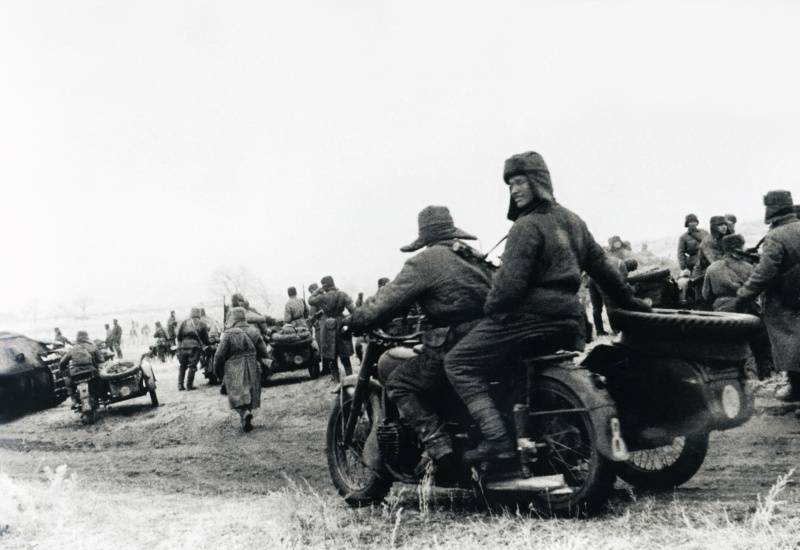
Soviet mechanized unit during the offensive at Stalingrad
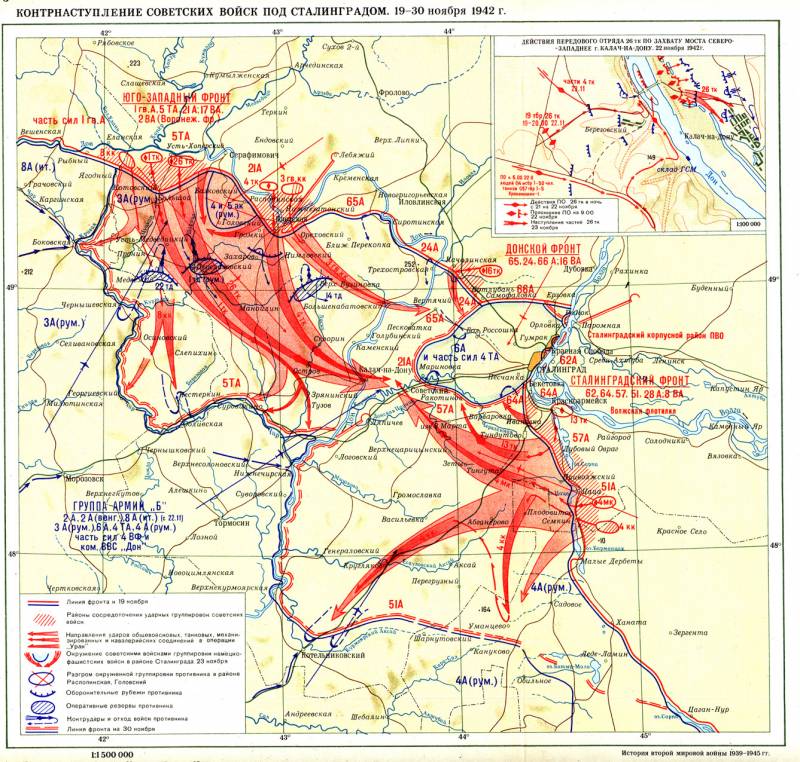

Information